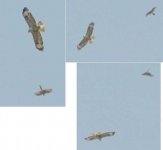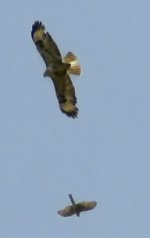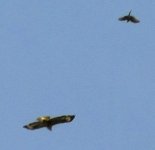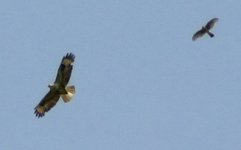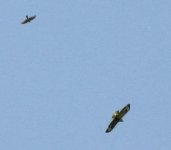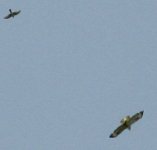-
Welcome to BirdForum, the internet's largest birding community with thousands of members from all over the world. The forums are dedicated to wild birds, birding, binoculars and equipment and all that goes with it.
Please register for an account to take part in the discussions in the forum, post your pictures in the gallery and more.
You are using an out of date browser. It may not display this or other websites correctly.
You should upgrade or use an alternative browser.
You should upgrade or use an alternative browser.
***Red Kite? (Possible Long-legged Buzzard in UK) (1 Viewer)
- Thread starter TerryH
- Start date
More options
Who Replied?gerdwichers8
Well-known member
Hello,
Before I scrolled down, I didn't know this thread was raised a new few weeks back. But at first glance, it struck me immediately as a bird I ve seen for one full week at Urim some years ago(structurally), less so as the Rough leggeds last summer and autumn. Long legged appears indeed more eagle-like broader winged than even Rough legged but I find it in its lower chest or belly a remarkable, bulk, again heavier as in Rough legged, typical for this species.
The plumage is easier.
But how it would compare to other, large buteo's on the globe, I don't know.
Before I scrolled down, I didn't know this thread was raised a new few weeks back. But at first glance, it struck me immediately as a bird I ve seen for one full week at Urim some years ago(structurally), less so as the Rough leggeds last summer and autumn. Long legged appears indeed more eagle-like broader winged than even Rough legged but I find it in its lower chest or belly a remarkable, bulk, again heavier as in Rough legged, typical for this species.
The plumage is easier.
But how it would compare to other, large buteo's on the globe, I don't know.
eric kitchmo
Active member
this bird looks very much like a long legged buzzard,that would be an amazing record not only for britian but for cambs! interestingly a red tailed hawk paired with a buzzard in cambridgeshire in 2003,not to far from huntingdon.they reared 2 hybrid young.maybe a hybrid is more likely.
this bird looks very much like a long legged buzzard,that would be an amazing record not only for britian but for cambs! interestingly a red tailed hawk paired with a buzzard in cambridgeshire in 2003,not to far from huntingdon.they reared 2 hybrid young.maybe a hybrid is more likely.
Are there any photos of the hybrids? Terry's bird was photographed in 2003, and is arguably a 2nd c.y. bird.
Here's a 1st summer LLB for comparison:
http://www.tarsiger.com/images/komi/but_ruf_pk_8331.jpg
It looks pretty similar, but hybrids between Common Buzzard and Red-tailed Hawk can probably look similar, too (at least I would think so...).
eric kitchmo
Active member
sorry no photos that i know of.buzzard and red tailed hawk have also been paired in norfolk in the last ten years.it seems probable that this pairing goes on most years in the region.
I have seen what I believed to be one of the Red-tail X Common Buzzard progeny (a first summer) in Lincs. It vaguely resembled Long-legged Buzzard in plumage and structure, but had many anomalous features, e.g. dark streaking on head and breast, bold dark leading and trailing edges to wings etc..
This bird, on the other hand, looks spot on for Long-legged Buzzard. I'm sure a hybrid Red-tail X Common Buzzard would always have a much darker leading edge to the wing than this. I think this is universal to Red-tailed Hawks, and ought to be enough to eliminate the hybrid possibility, given that Common Buzzard also generally have dark(ish) leading edges.
http://www.pbase.com/image/68940993
Size and shape also look good for Long-legged - and remember that we could be dealing with the much smaller North African form cirtensis, which I guess is the form that occurs as a vagrant in Iberia, although I'm not sure if that is known for certain. I saw one arrive in/off from N. Africa at Tarifa (Spain) once, but Sakers, Pallid Harriers and other eastern raptors also occur there occasionally, so that isn't conclusive evidence... Does anyone known whether any previous Long-legged vagrants to western Europe have been conclusively identified to subspecies?
In any case, this is a really jaw-dropping set of pictures, and surely worth circulating with the BBRC/BOU, even if only as a "probable"...
This bird, on the other hand, looks spot on for Long-legged Buzzard. I'm sure a hybrid Red-tail X Common Buzzard would always have a much darker leading edge to the wing than this. I think this is universal to Red-tailed Hawks, and ought to be enough to eliminate the hybrid possibility, given that Common Buzzard also generally have dark(ish) leading edges.
http://www.pbase.com/image/68940993
Size and shape also look good for Long-legged - and remember that we could be dealing with the much smaller North African form cirtensis, which I guess is the form that occurs as a vagrant in Iberia, although I'm not sure if that is known for certain. I saw one arrive in/off from N. Africa at Tarifa (Spain) once, but Sakers, Pallid Harriers and other eastern raptors also occur there occasionally, so that isn't conclusive evidence... Does anyone known whether any previous Long-legged vagrants to western Europe have been conclusively identified to subspecies?
In any case, this is a really jaw-dropping set of pictures, and surely worth circulating with the BBRC/BOU, even if only as a "probable"...
Last edited:
Ghostly Vision
Well-known member
Can this thread be re-titled to raise its profile?
This is a potentially very significant record for Britain!
Just in case it helps, I have lightened the image; a dark line can be clearly seen on the leading edge of the wings.
For me it doesn't seem to have the right jizz for LLB, and certainly smacks initially of Common buzzard, perhaps of the eastern race vulpinus.
Sean
This is a potentially very significant record for Britain!
Just in case it helps, I have lightened the image; a dark line can be clearly seen on the leading edge of the wings.
For me it doesn't seem to have the right jizz for LLB, and certainly smacks initially of Common buzzard, perhaps of the eastern race vulpinus.
Sean
Attachments
Last edited:
Jane Turner
Well-known member
Thread re-titled.
I'm still not seeing an overwhelming LLB wing structure either - like 4 years back! Then again I'm only familiar with birds in Eastern Europe
I'm still not seeing an overwhelming LLB wing structure either - like 4 years back! Then again I'm only familiar with birds in Eastern Europe
Last edited:
gerdwichers8
Well-known member
Steppe Buzzard in juvenile plumage is very slender and long winged compared to Common Buzzard.Broader wings look shorter to the yet heavier body in a Common.
Compared to Long legged, a Steppe Buzzard shows a different shape to the wing;more pointed to the hand, less parallel in both lines of the leading and rear edge.
This photo shows a bird which has a parallel outlined leading and rear edge and the hand ends square ended so..the wingformula is none Steppe.
How the body compares to the still long but broader wings is neither a Steppe feature.
The bodybulk is best considered as heavy in the first two pictures while the gliding bird in the third, shows a LLB fashion (Length of the wing and suggestive wingposition)
Compared to Long legged, a Steppe Buzzard shows a different shape to the wing;more pointed to the hand, less parallel in both lines of the leading and rear edge.
This photo shows a bird which has a parallel outlined leading and rear edge and the hand ends square ended so..the wingformula is none Steppe.
How the body compares to the still long but broader wings is neither a Steppe feature.
The bodybulk is best considered as heavy in the first two pictures while the gliding bird in the third, shows a LLB fashion (Length of the wing and suggestive wingposition)
KnockerNorton
Well-known member
I think this is the well-known bird in the Huntingdon area. I've spent a few summers around there working on other stuff, and it's been seen since at least 2003-6. In fact, a mate of mine found its nest a few years ago. It's definately a common buzzard, albeit one with a strikingly rufous tail. It's often reported as something funny, and seems to be based around Sawtry. I suppose it could be one of the hybrid young from the mixed pair, but it's been breeding with a normal female common buzzard for a few years. That's assuming it's the same bird, of course. It looks like it though - there aren't too many buzzards like that knocking around Hunts.
Last edited:
I think this is the well-known bird in the Huntingdon area. I've spent a few summers around there working on other stuff, and it's been seen since at least 2003-6. In fact, a mate of mine found its nest a few years ago. It's definately a common buzzard, albeit one with a strikingly rufous tail. It's often reported as something funny, and seems to be based around Sawtry. I suppose it could be one of the hybrid young from the mixed pair, but it's been breeding with a normal female common buzzard for a few years. That's assuming it's the same bird, of course. It looks like it though - there aren't too many buzzards like that knocking around Hunts.
If this bird was a Common Buzzard, it surely would have more abnormal features than just a rufous tail (of course Steppe Buzzards often have a rufous tail):
-The central newly moulted rectrices seem to be extremely pale and slightly orange toned, lacking any barring and subterminal band (of course fine barring wouldn't necessarily be visible in the photo, but I think that the broader subterminal band common to both the nominate subspecies and vulpinus should indeed be visible). Especially for a nominate CB, such a colour of the adult rectrices would be extremely atypical.
-The belly is dark, contrasting against a pale breast and head. I have never seen a Common Buzzard with such patterning, and never heard of something like that being described anywhere. Steppe Buzzards have usually uniformly coloured bodies, although usually with a breast band (there is no pale morph of Steppe Buzzard). There exists of course a pale morph of nominate CB, but this colour combination should still be at least highly atypical.
-The secondary underwing coverts are usually clearly three coloured on Steppe Buzzards: pale median and dark greater and lesser coverts. The lesser coverts of this bird look slightly darker than the median, but they still look very pale compared to the greater coverts and the carpal patches. On pale morph nominate CBs, the underwing secondary coverts are usually completely white, and on the other hand, the remiges very dark.
-Like Gerd wrote, the body looks really bulky.
Last edited:
KnockerNorton
Well-known member
If this bird was a Common Buzzard, it surely would have more abnormal features than just a rufous tail (of course Steppe Buzzards often have a rufous tail):
I don't follow...
-The central newly moulted rectrices seem to be extremely pale and slightly orange toned, lacking any barring and subterminal band (of course fine barring wouldn't necessarily be visible in the photo, but I think that the broader subterminal band common to both the nominate subspecies and vulpinus should indeed be visible). Especially for a nominate CB, such a colour of the adult rectrices would be extremely atypical.
erm, I think the bird is lacking the central retrices - I think the very pale area you're seeing is inner webs of the next pair. It looks like it's dropped the inner pair to me. Anyway, the Sawtry bird had what often looked like an almost unmarked rufous (variously orange or reddish depending on the light) tail when viewed from above.
There exists of course a pale morph of nominate CB, but this colour combination should still be at least highly atypical.
well, yes, the sawtry bird was highly atypical, and there's a chance it did have a bit of Red-tailed hawk in it. But it looked a lot like this bird, may in fact be the same one, and it wasn't a Steppe or Long-legged Buzzard, unless it was also the first UK breeding record.
The secondary underwing coverts are usually clearly three coloured on Steppe Buzzards: pale median and dark greater and lesser coverts. The lesser coverts of this bird look slightly darker than the median, but they still look very pale compared to the greater coverts and the carpal patches. On pale morph nominate CBs, the underwing secondary coverts are usually completely white, and on the other hand, the remiges very dark.
-Like Gerd wrote, the body looks really bulky.
Lots of 'usually' s there. The sawtry bird was a very odd looking buzzard, and was a noticeably small-ish male. But buzzards are very variable. Anyway, this photo may well be a totally different bird, and indeed be what you think it is. But I just thought I'd point out that less than 5 miles away, at the same time, was a funny common buzzard with a red tail, looking not dissimilar from this bird, messing about on a nest with a 'normal' common buzzard. Thought it could be relevant.
I don't follow...
Sorry about the unclear language, what I meant was:
1. If this bird is a CB, then it has more abnormal features than just the tail colour.
2. Steppe Buzzards often have rufous tails
erm, I think the bird is lacking the central retrices - I think the very pale area you're seeing is inner webs of the next pair. It looks like it's dropped the inner pair to me. Anyway, the Sawtry bird had what often looked like an almost unmarked rufous (variously orange or reddish depending on the light) tail when viewed from above.
I have also been thinking about if it could be that the central pair is missing, and what we actually see is the inner webs of the next pair. However, on CBs the tail feathers are equally coloured on the inner and outer webs, and there seems to be a great contrast between center and the rest of the tail. But I admit that you may be right, in wich case the contrast would be due to backlight.
well, yes, the sawtry bird was highly atypical, and there's a chance it did have a bit of Red-tailed hawk in it. But it looked a lot like this bird, may in fact be the same one, and it wasn't a Steppe or Long-legged Buzzard, unless it was also the first UK breeding record.
If there was an extremely atypical CB in the region (or maybe one with Red-tailed Hawk blood in it), that looked EXACTLY like this bird, then it was very probably the same individual. Is there any description of the body or underwing colour of the red-tailed CB? Or are there any reasons for it being a CB, other than nesting in Britain (vagrant Long-legged Buzzards wouldn't probably nest with a CB, but different Buzzard hybrids might do so with a greater probability)?
Lots of 'usually' s there. The sawtry bird was a very odd looking buzzard, and was a noticeably small-ish male. But buzzards are very variable. Anyway, this photo may well be a totally different bird, and indeed be what you think it is. But I just thought I'd point out that less than 5 miles away, at the same time, was a funny common buzzard with a red tail, looking not dissimilar from this bird, messing about on a nest with a 'normal' common buzzard. Thought it could be relevant.
Yes, it is definitely relevant to point out that. I just wanted to point out that the tail colour is not the only abnormal feature about the bird, if the same bird is really shown on Terry's pictures. I'm also fully aware that a Long-legged Buzzard have never been reocrded in Britain, and that therefore the possibility of this bird being some really atypical CB or hybrid can not at all be neglected, and is even probable, if a completely similar CB was present in the same area. BTW, was this red-tailed CB with certainty a different individual than the Red-tailed Hawk, which was apparently also nesting in the same area?
Last edited:
gerdwichers8
Well-known member
It is true that the most abnormal buzzards are seen in Western Europe these days but it is equally true these birds show a set of abnormal features. Abnormal to the plumages of real species and very definite equally so, subspecies.
To me, a combination of dark feathers to the carpal, the lesser and greater coverts and sides of the flank is odd to understand now the tail remains unpatterned as such.
This is why:
In the Netherlands we get birds we need to check because they so much resemble Roug-legged Buzzards (and yes, birds with redder pigmentation are not rare, even though this is not endemic to the Low Lands, the origin is not natural).
The so called 'Rough legged type' can be a difficult hybrid plumagewise but by passing the full set of features these are found out and especially the tail is seen upon barring to the corners and terminal not to be 'Rough-legged'.
But yet, structure is always a give away!
In case of a clean tail it is hard to understand how this could be the solution to this bird.
The hybrids don't show very wide and crisp terminal black bars as Rough legged but always partly a type of barring found usually in Common.
In case of a 'Long legged type' hybrid, how would it get such an unbarred tail with at least one parrent being a Common Buzzard which has to give the offspring much broader barring than even a Steppe Buzzard? The unknown parrent 'X' needs to have an unbarred tail.
Merely for the sake of reflection:
X = e.g Kridder's Red Tailed Hawk?
To me, a combination of dark feathers to the carpal, the lesser and greater coverts and sides of the flank is odd to understand now the tail remains unpatterned as such.
This is why:
In the Netherlands we get birds we need to check because they so much resemble Roug-legged Buzzards (and yes, birds with redder pigmentation are not rare, even though this is not endemic to the Low Lands, the origin is not natural).
The so called 'Rough legged type' can be a difficult hybrid plumagewise but by passing the full set of features these are found out and especially the tail is seen upon barring to the corners and terminal not to be 'Rough-legged'.
But yet, structure is always a give away!
In case of a clean tail it is hard to understand how this could be the solution to this bird.
The hybrids don't show very wide and crisp terminal black bars as Rough legged but always partly a type of barring found usually in Common.
In case of a 'Long legged type' hybrid, how would it get such an unbarred tail with at least one parrent being a Common Buzzard which has to give the offspring much broader barring than even a Steppe Buzzard? The unknown parrent 'X' needs to have an unbarred tail.
Merely for the sake of reflection:
X = e.g Kridder's Red Tailed Hawk?
Last edited:
gerdwichers8
Well-known member
but I think that the broader subterminal band common to both the nominate subspecies and vulpinus should indeed be visible).
In most cases this is yes, it s true but in juvenile and 2 cy plumage this is most times not showing and more rarely in some Steppe adults alltogether or partly lacking.
How this is in Common; I never saw any without barring distally (at least)
TerryH
Well-known member
I'm amazed
I am amazed how this thread has continued over the years. I still do a lot of Birding but don't seem to have the time to keep up with forums these days.
I was contacted by "Ghostly Vision" today and decided to hunt the pics out and put them back up. These are 100% crops from the originals and now with some more knowledge than 4 years ago I do think this is a Rough-Legged Buzzard do to the dark patches under the wings, and from reference photos in my books.
If I'm wrong please accept my apologies.
Terry
I am amazed how this thread has continued over the years. I still do a lot of Birding but don't seem to have the time to keep up with forums these days.
I was contacted by "Ghostly Vision" today and decided to hunt the pics out and put them back up. These are 100% crops from the originals and now with some more knowledge than 4 years ago I do think this is a Rough-Legged Buzzard do to the dark patches under the wings, and from reference photos in my books.
If I'm wrong please accept my apologies.
Terry
Attachments
I am amazed how this thread has continued over the years. I still do a lot of Birding but don't seem to have the time to keep up with forums these days.
I was contacted by "Ghostly Vision" today and decided to hunt the pics out and put them back up. These are 100% crops from the originals and now with some more knowledge than 4 years ago I do think this is a Rough-Legged Buzzard do to the dark patches under the wings, and from reference photos in my books.
If I'm wrong please accept my apologies.
Terry
Hello Terry,
thanks for the new photos! Rough-legged Buzzard is not at all a bad suggestion, but the colour of the tail doesn't fit. Rough-legged Buzzards have a broad dark subterminal band to the tail in all plumages, and the tail should also lack rufous tones completely.
We are dealing with a very special looking bird, and even one of the best experts in the world (Dick Forsman) has agreed that your bird looks very much like a Long-legged Buzzard. However, like Dick mentioned, there are not enough details visible in the photos for a certain id. In the same region both a Red-tailed Hawk and a Common Buzzard with a special looking rufous tail have occured, with the Red-tailed Hawk hybridizing with a Common Buzzard. Also the possibility of an escaped Upland Buzzard, which is an Asian species, cannot be completely ruled out, as they are very similar to Long-legged Buzzards.
Although it seems like the species of your bird cannot be established with certainty, it can be aged as 2nd calendar year bird (i.e. it was hatched in 2002), due to the indistinct trailing edge of the wing. Adult birds of all European buzzard species have a rather well marked dark trailing edge. As can be seen from the pictures, the bird has already started to moult to adult plumage, the innermost primaries belong to a new generation (with some primaries growing on both wings forming the notches).
draycotebirding
Draycote recorder
Just wondering if anyone else remembers a buzzard with a rufous tail being reported in Leicestershire a few years ago Belvoir Valley I think?
What became of this record?
Regards
John
What became of this record?
Regards
John
gerdwichers8
Well-known member
Mm, yes, even Dick Forsman is in trouble
http://www.orientalbirdimages.org/b...pecies&Bird_ID=901&Bird_Family_ID=&pagesize=1
http://www.orientalbirdimages.org/b...pecies&Bird_ID=901&Bird_Family_ID=&pagesize=1
or perhaps it helps him to persuade others to raise some funds for ID research
The following links might be very helpful
http://www.birds.kz/Buteo hemilasius/index.html
http://sjl.csie.chu.edu.tw/phpBB2/viewtopic.php?t=56
http://www.orientalbirdimages.org/b...pecies&Bird_ID=901&Bird_Family_ID=&pagesize=1
http://www.orientalbirdimages.org/b...pecies&Bird_ID=901&Bird_Family_ID=&pagesize=1
or perhaps it helps him to persuade others to raise some funds for ID research
The following links might be very helpful
http://www.birds.kz/Buteo hemilasius/index.html
http://sjl.csie.chu.edu.tw/phpBB2/viewtopic.php?t=56
Last edited:
Users who are viewing this thread
Total: 2 (members: 0, guests: 2)





